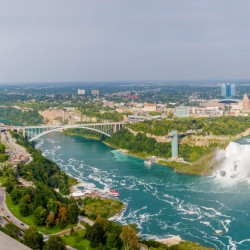4 of Niagara Falls’ Most Fascinating Historical Sites
March 2, 2015 12:00 pm In addition to being the home of one of the world’s most treasured and impressive natural wonders, Niagara Falls also lays claim to a fascinating and storied history that ranges from being a part of the Iroquois Confederacy to the Battle of Lundy’s Lane — one of the bloodiest fights to ever take place on Canadian soil.
In addition to being the home of one of the world’s most treasured and impressive natural wonders, Niagara Falls also lays claim to a fascinating and storied history that ranges from being a part of the Iroquois Confederacy to the Battle of Lundy’s Lane — one of the bloodiest fights to ever take place on Canadian soil.
For many visitors to the area, the initial draw of stunning waterfalls, award-winning restaurants, family fun, and world-class accommodations gives way to a curiosity about the place itself — a curiosity that’s both stoked and satisfied by four of Niagara Falls’ most interesting historic sites.
1. Heritage Railway Station of Canada
Built in 1879 by the Great Western Railway at a time when fierce competition existed between Ontario’s rail companies, this two-story Gothic Revival railway station is located in the heart of the city. A rare example of Gothic revival architecture along the rails, its massive and formidable brick design is still impressive today. For the lover of trains and railway culture, this station is itself a gem, but it’s the station’s functional importance toward the end of the 19th century and the beginning of the 20th that helped establish Niagara Falls as a tourism and agriculture center.
2. Battle of Lundy’s Lane National Historic Site
This site marks the Battle of Lundy’s Lane, a fight between British and American soldiers that occurred on July 25, 1814 during the War of 1812. For six hours, the two sides battled, and the result was one of the bloodiest battles of the entire war. Fought on a peaceful bit of cleared farmland that, at the time, was flanked by orchards and forest, the site features a museum that offers an informative self-guided walking tour and brochure for visitors who wish to experience the more salient features of the battle. Drummond Hill Cemetery is also here with many graves that pre-date the War of 1812.
 3. R. Nathaniel Dett British Methodist Episcopal Church
3. R. Nathaniel Dett British Methodist Episcopal Church
Another National Historic Site of Canada, this British Methodist Episcopal Church is located in a residential neighborhood near the city’s business district. A small wooden church, the site pays homage to Niagara’s earliest black settlers and the church’s role in helping runaway slaves from the United States, making it an important stop along the Underground Railroad. Originally built in 1836, the chapel was named for Nathaniel Dett in 1983, a parishioner who rose to international fame as a composer and musician. The site is also the current home of the Norval Johnson Heritage Library, which features a collection related to the local community’s history.
4. Toronto Power Generating Station
While its name is considerably lackluster, the Toronto Power Generating Station, located just above Niagara Falls on the banks of the Niagara River, was one of the most revolutionary hydro-electric facilities in the world when it opened in 1906. Designed by E. J. Lennox, a Toronto architect, the Beaux-Arts design complements its stunning location and is highly unusual for an industrial site. Now vacant, the building’s neoclassical design, impressive columns, and regal limestone façade still maintain a stately and formidable elegance amidst the area’s natural beauty.
Whether or not you’re a history buff, take a day or two to visit these Niagara Sites. You’ll gain greater insight and appreciation into the heritage and people who have helped mold the area into what it is today.
Categories: Falls Avenue Resort

